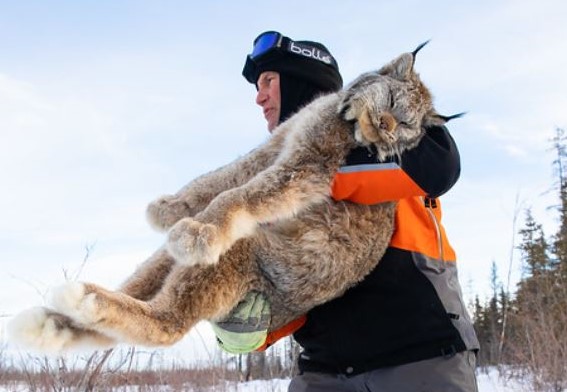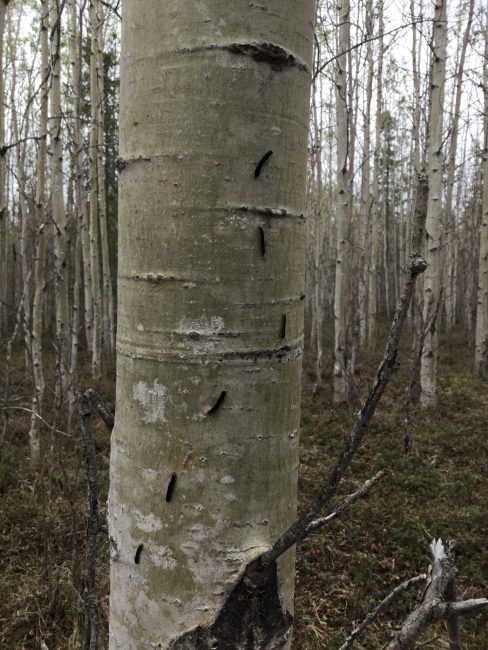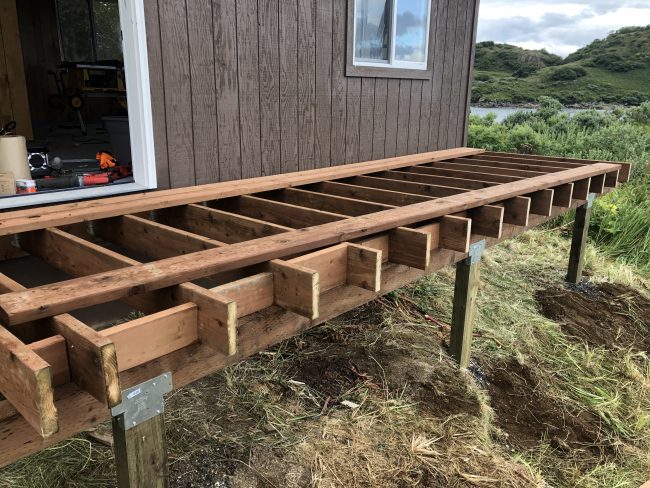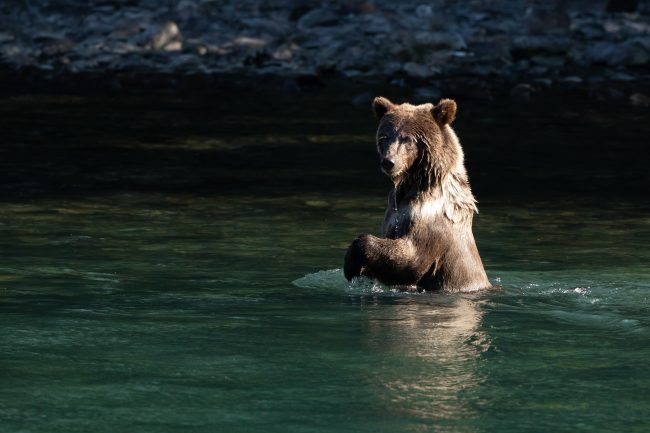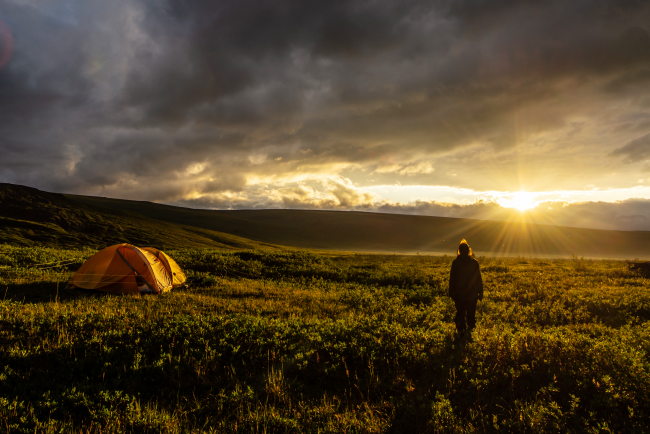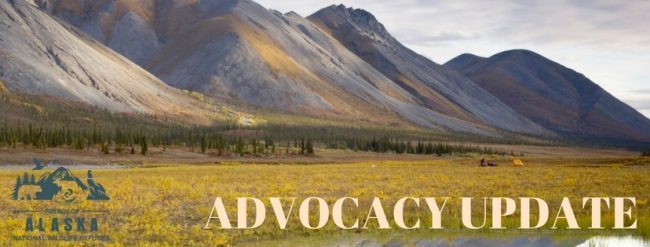Tuesday, October 20, 2020, 5 pm AKDT. View Recorded Video
Please join us on Tuesday, October 20, 2020, 5-6pm (AKDT), for our Friends monthly meeting.
Month: October 2020
Insects Matter: Battered Sallow Moth Outbreak on the Kenai Refuge
By Matt Bowser, Entomologist at Kenai National Wildlife Refuge
In early June, I received multiple accounts of abundant black caterpillars stripping foliage along the Marsh Lake Trail on Kenai National Wildlife Refuge. Dark caterpillars were subsequently reported from Cooper Landing to Sterling to Kasilof. These larvae consumed leaves of aspen, highbush cranberry, birch, willows, roses, soapberry, and almost any other broad-leaved plant. Steve Swenson of the USDA Forest Service tentatively identified them as caterpillars of the battered sallow moth (Sunira verberata). This identification was confirmed when caterpillars my kids and I raised in canning jars eventually emerged as adults in July.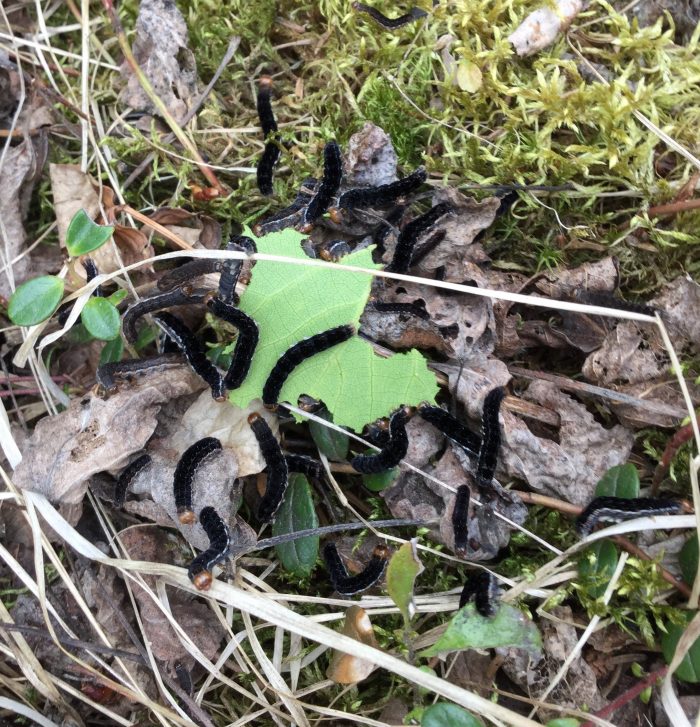
Battered sallow moth caterpillars finish off a leaf on Marsh Lake Trail on Kenai National Wildlife Refuge. Multiple years of defoliation can lead to tree and shrub mortality. Credit: Cynthia Detrow
We periodically see outbreaks of these caterpillars in southern Alaska. The last event was in 2017, when they were seen in numbers along the Richardson Highway and in the Mat-Su, Anchorage, and Kenai Peninsula. The largest recorded outbreak of battered sallow moth caterpillars happened during 2003–2006 on the Alaska Peninsula, when up to 20,000 acres of alders and willows were damaged annually. That outbreak, which may have included speckled green fruitworm moths, killed alders on mountain slopes over large areas. Deciduous trees and shrubs like alders and willows can usually withstand multiple years of their leaves being consumed without suffering lasting damage, so the severity of that event was notable.
Although the battered sallow moth naturally occurs from Alaska to central Canada and south to Colorado, there is no record of outbreaks of this species outside our state. I wonder why battered sallow moths become so abundant in Alaska but nowhere else. As with other forest caterpillars with periodic cycles of abundance, declines are likely caused mainly by diseases and parasites that pass through the populations. At least one other sallow moth species is attacked by short-tailed ichneumon wasps. The female wasp deposits an egg into a mature caterpillar, and the developing wasp larva will eventually kill its host during the moth’s pupa stage.
A Forest Service report links the 2003–2006 outbreak to higher than normal temperatures, but there’s not enough information yet to explain why higher temperatures might lead to increased populations. In related moths, outbreaks are often terminated by “zombie viruses” that rapidly sweep through dense caterpillar populations. The virus alters the caterpillars’ behavior, causing them to stop feeding and climb to the tops of trees. There the caterpillars die and disintegrate, spreading virus particles over the foliage below, where they can be eaten by other caterpillars. In some species the infected cadavers become attractive to other caterpillars, which cannibalize them and then become “zombie caterpillars” themselves.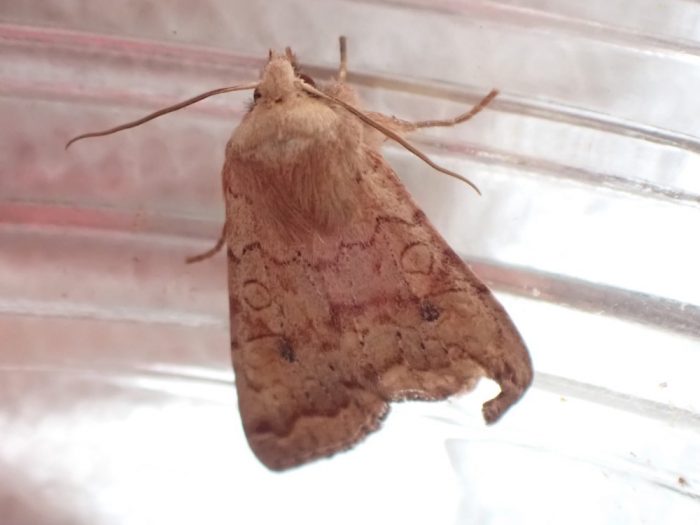
An adult battered sallow moth that emerged from caterpillars raised by Matt Bowser (Kenai Refuge entomologist) and his kids this summer. The caterpillars were provided by Dan Thompson (ADF&G biologist)
Adult battered sallow moths began emerging in late July, continuing into this fall when they presumably lay eggs. The life history of this species has not been worked out, so we do not know when the eggs hatch and larvae begin feeding. The larvae may hatch in the fall, feed and grow some, then overwinter as small caterpillars. Alternatively, the eggs may hatch in early spring. We do know that the caterpillars are out by the beginning of June.
I will pay attention to what happens on the Kenai Refuge this year and next. In general, we would expect trees and shrubs to recover quite well from this year’s damage unless there are high numbers of battered sallow moth caterpillars consuming leaves for multiple years. It’s also possible that other defoliators, like the recently introduced green alder sawfly, may have additive effects on mortality events, an increasing problem as nonnative insects and a warming climate collide.
See a Refuge Cabin Trip in your Future? Kodiak has a New One
Want to “Live Your Wild” in a refuge cabin? Kodiak, Kenai and Tetlin all have public use cabins and Kodiak just added a new one. There are now nine public use cabins scattered across the Kodiak National Wildlife Refuge. The most recent addition to the cabin system came “online” in September, and graces a serene site along the Chief Cove shoreline.
Since all of Kodiak’s cabins are remotely located, the logistics were a bit more involved to get construction crew and materials on-site. Success was enhanced by all of the pre-planning and preparations that took place prior to leaving the refuge headquarters. In most years, support could also be provided by refuge pilots, but this year because of COVID-19 concerns, gear and personnel transportation depended entirely on using the refuge vessel Ursa Major II.
We have maintenance workers Danny Hernandez, Darrel Fox, and Kyle Coleman to thank for their efforts and expertise in building the Chief Cove cabin over two weeks in early September. The construction crew is happy that their work will allow increased access to and appreciation of refuge lands.
The previously established cabins are in Blue Fox, Deadman, and Viekoda bays, North Frazer, South Frazer, and Uganik lakes, Uganik Island, and Little River. Each cabin allows visitors to spend extended time exploring the beautiful and breath-taking Kodiak NWR lands and wildlife. While the cabins are sturdy, nicely appointed, and comfortable, they will, no doubt, also serve as safe shelters from the elements. All are priced at $45/night, and all have bunk beds to accommodate 4 people (except the Deadman Bay cabin that accommodates 8).
To browse refuge public use cabins and what they have to offer or reserve a cabin follow these links for Kenai and Kodiak on recreation.gov and this link to the refuge website for information on Tetlin’s. All refuge cabins are very popular so plan ahead.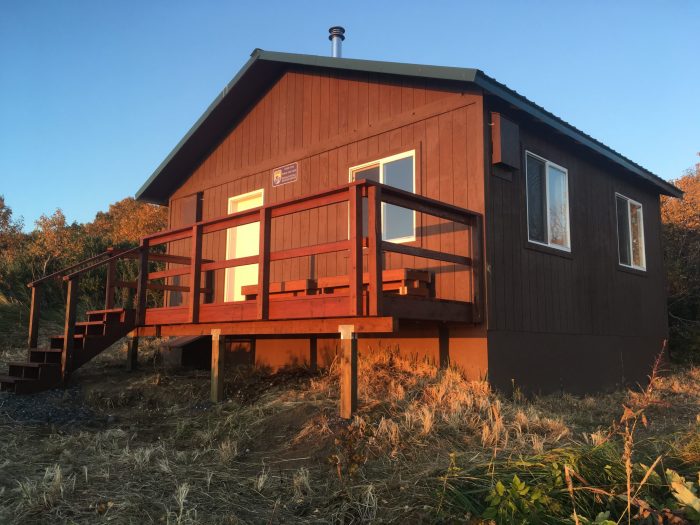
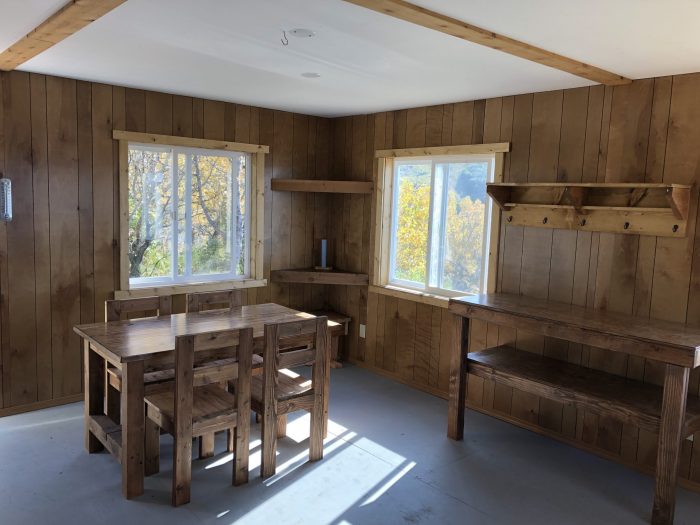
Kenai Public Hearing Scheduled, Comment Period Reopens
Thanks to all of your comments critical of the proposed changes to trapping, bear baiting, and other Kenai Refuge regulations plus letters from Friends and other conservation partners requesting a public meeting, the Department of the Interior granted our request for a hearing and another 30-day comment period. The comment period is open until November 9, and the virtual public hearing will be October 26 at 4 pm, AKDT.
Testimony at the virtual meeting is important because our passion on this issue took the other side by surprise and may bring them out in force. You must pre-register for the meeting at this link. You can read the Federal Register Notice here. Comment electronically here. Comments you submitted in the first round prior to August 10 will be considered in the final analysis, but we encourage you to take advantage of this opportunity to raise other issues and describe how these changes will affect your personal enjoyment of the refuge.
Under pressure from the State of Alaska, the Department of the Interior required the Fish & Wildlife Service to propose new rules that would negatively affect brown bears, trapping, visitor access, and public safety on the Kenai National Wildlife Refuge. These changes would seriously weaken refuge regulations that were developed through extensive public processes and agreements with the state that cover 40 years. The proposed rules were released in June with a comment period that closed in August without a public hearing. Over 34,000 comments were received, in addition to tens of thousands of petition signers.
Proposed Rules would allow brown bear hunting over bait for the first time. Hunters could use human food to lure bears to bait stations up the Swanson River Road, jeopardizing the safety of visitors and oil field workers. This unsporting hunting method is highly effective at killing bears and will have detrimental consequences on the refuge’s brown bear population.
Proposed Rules would open new areas to trapping and eliminate the safeguards in the refuge trapping program. The Kenai Refuge would no longer be allowed to manage trapping on the refuge and the state, with it lax trapping rules, would take over resulting in these negative impacts:
- Elimination of the 1 mile no-trap buffer around trailheads, campgrounds and roads
- Elimination of special provisions to prevent trapping birds of prey
- Elimination of provisions to prevent overharvest of species of concern
- Elimination of required refuge permits, trapper orientation, trap marking and trap checking
- Elimination of the ban on toothed leg-hold traps
Other provisions of the Proposed Rules would allow bicycles, game carts, and ATVs on some roads, frozen lakes, and trails and permit the discharge of firearms along the Kenai and Russian Rivers from November 1 to May 1. This would endanger public safety, increase the killing of watchable wildlife, and seriously degrade visitor experiences.
Visit the Kenai Regulations page on our website for a chart comparing existing regulations to these changes, information on how to comment non-electronically, advice on how to submit effective comments and more background information.
Live Your Wild: Celebrating our Refuges
In Alaska, we are shared stewards of world renowned natural and cultural resources on sixteen national wildlife refuges that span a vast and diverse state. They are the traditional homelands of our Alaska Native neighbors, who continue to practice a subsistence way of life that nourishes body and spirit. These refuges call to people from around the globe, offering once-in-a-lifetime experiences, iconic creatures, and spectacles of migration. For the people who live here, and for those who visit, these places give us a true refuge and solace in difficult times. From the far reaches of the Aleutians and the Arctic to the nearby trails of the Kenai, the wildness of Alaska’s national wildlife refuges sustains us.
During October 11th-17th, connect with us to explore more:
Find new stories, activities, and virtual events from refuges around the state on our Alaska Facebook page each day.
Make an Alaskan refuge your office and dream of your next visit. This album is for you.
Check out some of our virtual tours and lessons, including art, yoga, and nearby nature exploration.
Check out the big picture: connect with other refuges in the system and meet some of our Champions of Conservation who played a big role in who we are today. Follow along with daily features on the National Wildlife Refuge System Facebook page.
Are you a Refuge Super Fan? Share how you “Live Your Wild” on your social media using #WildlifeRefuge, and add a special frame to your Facebook profile and find your community. Choose to add a frame, and search “National Wildlife Refuge Super Fan” when editing your profile photo.
Advocacy Report October 2020
By David Raskin, Friends President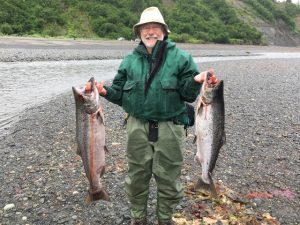
Kenai Regulations
We were successful in forcing the DOI to reopen the comment period for 30 days beginning on October 9 and schedule a virtual hearing on October 26. See the lead article in this newsletter for details. This major effort was led by the Alaska Wilderness Alliance, Defenders of Wildlife, and Alaska Friends.
Arctic National Wildlife Refuge
We are still waiting to hear about the expected call of nominations for oil leases. The window is narrowing for this process to unfold before a new administration is installed in January.
The village of Kaktovik and the Arctic Slope Regional Corporation are exploring ways to drill for oil and gas on the inholdings in the Coastal Plain. They are planning to do seismic exploration this winter on their lands in the eastern area of the Coastal Plain. They will need to get permits from the USFWS, and the Arctic Refuge Defense Campaign (ARDC) and Friends will be monitoring any developments and will take action if needed.
The ARDC campaign’s highly successful meetings with financial institutions concerning the dangers of Arctic drilling and the financial risks of supporting such efforts reached another milestone with the announcement by the Royal Bank of Canada that they will not fund drilling in the Arctic Refuge. This is a major development that we hope will encourage other Canadian financial institutions to take this step to protect the arctic and their people who depend on it for subsistence and traditional ways of life. ARDC has continued their pressure on Bank of America and oil and gas development companies to join the major financial institutions in refusing to fund oil development in the arctic.
Izembek National Wildlife Refuge
The latest development is a refurbished effort by the State of Alaska to obtain a road right-of-way to connect inholdings in King Cove with Cold Bay. This is a new tactic to represent individual landowners in King Cove that is very complicated and hopefully will fail to meet the requirements for standing. The State has been interested in doing this for many years, and Trustees for Alaska had addressed this in our recent lawsuits. We feel that it has little chance of success and remain vigilant for any attempts by the State and the Alaska delegation to sneak something through.
Pebble Mine
The Pebble Partnership took a big hit following the disclosures of their behind-the-scenes antics that provoked the ire of Senator Sullivan and others. We hope that the Army Corps of Engineers will stick to their recent position that the Pebble Project failed to provide satisfactory mitigation plans for the proposed mine. The Corps gave the Pebble project 90 days to propose stream and wetland mitigation plans, but it seems unlikely that they will be able to put together such a plan because of lack of options.
Mulchatna Caribou
The Mulchatna caribou herd has experienced declining populations for several years. It ranges over a huge area of Western Alaska that encompasses large portions of the Togiak and Yukon Delta Refuges. The State is asking to extend its current, unsuccessful predator control activities to lands within the refuges. However, this is not consistent with FWS management practices and is unlikely to achieve the State’s hopes of increasing the caribou population. Declines in the caribou numbers are most likely due to human predation and smaller impacts of habitat loss and other factors, and FWS is not likely to allow the State to kill predators on refuge lands.
